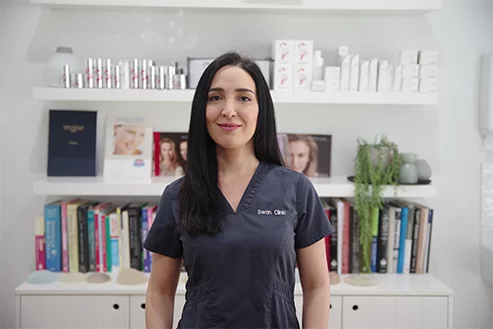Upper Back Surgery
Upper back surgery, is a surgical procedure that involves the removal of excess skin and, in some cases, fat from multiple areas of the upper torso. It is generally considered by individuals who have experienced significant changes in body composition due to weight loss, ageing, or other factors, and who have developed loose or redundant skin in areas such as the upper back, sides of the chest, and upper abdomen.
This procedure may be part of staged body surgery plan for patients following bariatric surgery or major weight fluctuations. It may also be combined with other procedures such as brachioplasty, breast surgery, or liposuction where appropriate.
What Does Upper Back Surgery Involve?
Commonly Combined Procedures
Upper body Surgery may include a combination of the following:
- Brachioplasty: Removes excess skin and fat from the upper arms.
- Mastopexy or Breast Reduction: Involves repositioning or reducing breast volume.
- Upper Back Surgery: Removes redundant skin from the upper and mid-back region.
- Liposuction: May be used to remove localised fat deposits in combination with skin excision.
Not all patients require every component. The procedure plan is developed based on clinical assessment and individual goals, discussed during consultation.
Who Might Consider This Procedure?
Upper body Surgery may be appropriate for individuals who:
- Have experienced significant weight loss resulting in excess skin across the arms, chest, or back.
- Have skin that has not naturally retracted following weight loss.
- Are at or near their goal weight and have maintained a stable weight for at least 6-12 months.
- Are in good general health and do not smoke, as smoking may affect wound healing.
A consultation with a qualified specialist is necessary to determine whether this procedure is appropriate for your individual circumstances.
Procedure Overview
- Anaesthesia: General anaesthesia is typically required.
- Duration: The procedure may take between 2 to 4 hours, depending on the extent of surgery.
- Incisions: Incisions are planned based on the areas treated. Surgeons aim to place them where they can be concealed by clothing where possible.
- Hospital Stay: In some cases, an overnight stay may be recommended. This will be discussed during pre-operative planning.
Potential Risks – Upper Body Surgery
As with all surgical procedures, Upper body Surgery carries general and procedure-specific risks, including:
- Infection at the surgical site, which may require antibiotics or further treatment
- Bleeding or haematoma (accumulation of blood under the skin)
- Scarring, which may be extensive and vary based on incision length and individual healing
- Delayed wound healing, particularly in areas with tension or where skin quality is reduced
- Fluid accumulation (seroma), which may require aspiration or drainage
- Asymmetry or irregular contouring after healing
- Skin or fat necrosis, especially in areas with reduced blood flow
- Changes in sensation, such as numbness, tingling, or hypersensitivity, which may be temporary or permanent
- Tissue tightness or restricted movement due to scarring or skin removal
- Persistent swelling or firmness in the surgical area
- Pain or discomfort beyond the expected recovery period
- Anaesthesia-related risks, including allergic reactions or cardiovascular or respiratory complications
Recovery and Aftercare – Upper Body Surgery
- Swelling, bruising, and discomfort are common and typically improve over several weeks
- Pain management may involve prescribed or over-the-counter medication, as directed by your surgeon
- Wound care and dressing changes will be explained and should be followed carefully to support healing
- Compression garments or binders may be recommended to support the area, reduce swelling, and minimise fluid build-up
- Strenuous activities, lifting, and upper body movements should be limited for 4–6 weeks, or as advised by your surgeon
- Driving should only be resumed once you are no longer taking prescription pain medication and can move safely
- Scarring may be significant; your surgeon may discuss options for scar management
- Positioning during rest or sleep may need to be adjusted to avoid tension on the surgical area
- Smoking and alcohol should be avoided during recovery, as they may impair wound healing
- Final results may take several months to settle as swelling subsides and tissues adjust
- Follow-up appointments are important to monitor healing and manage any complications early
If you have any questions or wish to discuss upper body surgery options, please contact our clinic to schedule a consultation with Dr Reema Hadi.

